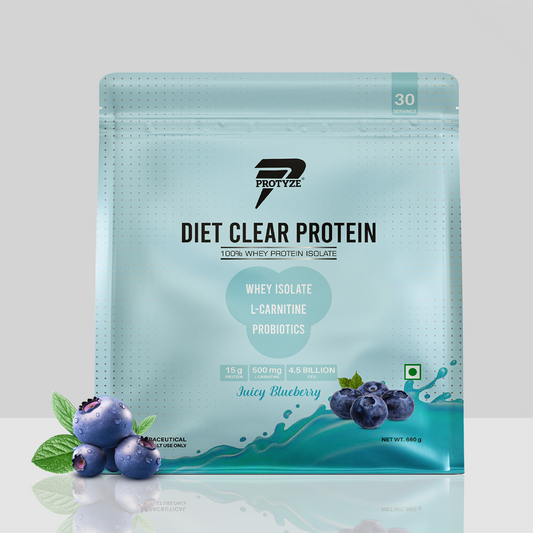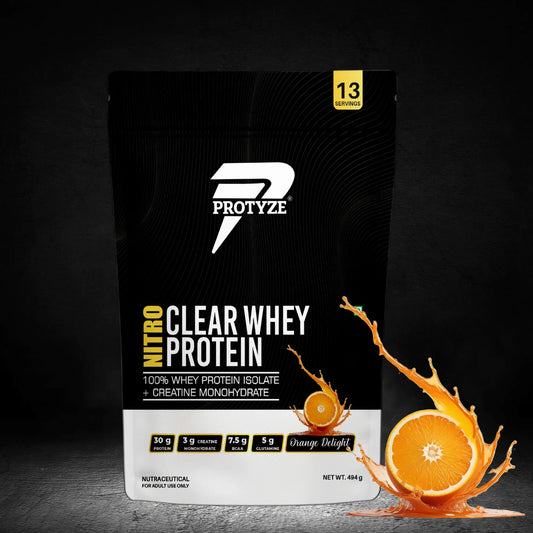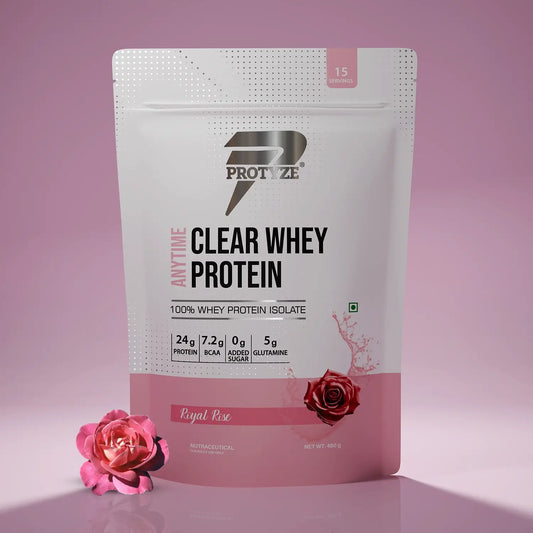Purines are natural compounds found in certain foods that, when broken down, produce uric acid in the body. While uric acid is normal, excessive levels can lead to health issues like gout, kidney stones, or joint inflammation, particularly for those predisposed to high uric acid levels.
Managing purine intake is key to maintaining better health, especially for Indian fitness enthusiasts balancing active lifestyles with cultural diets rich in pulses and seafood. In this blog, we’ll explore five high-purine foods you should limit, their impact on health, and how to adopt a low-purine diet, tailored for India’s dietary habits. We’ll also reference Protyze Diet Clear Whey, a low-calorie protein option, to support a balanced, health-focused diet. Let’s dive into smarter food choices for optimal wellness!
Understanding Purines and Their Impact
Purines are found in animal and plant foods, metabolized into uric acid, which is excreted by the kidneys. High-purine diets can overwhelm this process, raising uric acid levels and increasing risks of:
- Gout: Painful joint inflammation from uric acid crystal buildup, affecting ~1-2% of Indians, per a 2019 study.
- Kidney Stones: Uric acid stones form in 10-15% of stone cases, per a 2020 study.
- Joint and Kidney Issues: Chronic high uric acid may strain kidneys and cause discomfort.
In India, where diets include purine-rich foods like lentils and fish, and urban lifestyles (stress, processed foods) exacerbate health risks, limiting high-purine foods is crucial. Below, we detail five high-purine foods to reduce, their purine content, health effects, and low-purine alternatives, with dietary strategies to support better health.
5 Common High Purine Foods You Should Avoid
Here is the list of 5 foods with high purines that you can avoid to maintain your healthy lifestyle.
1. Red Meat

Red meats like beef, mutton, and pork contain 100-200 mg purines per 100g, classifying them as high-purine, per a 2018 study. In India, mutton curries and biryanis are staples, especially during festive seasons like Eid or Diwali, but frequent consumption elevates uric acid.
Health Impact
Excessive red meat intake increases gout risk by 20-30%, per a 2019 study, due to uric acid buildup. It’s also high in saturated fats (~5-10g/100g), contributing to weight gain and inflammation, which worsen joint and kidney health.
How to Limit
- Reduce Frequency: Limit red meat to 1-2 times monthly instead of weekly.
- Portion Control: Keep servings to 50-70g (palm-sized) to lower purine intake (~50-100 mg).
- Alternatives: Choose low-purine proteins like eggs (0-50 mg purines/100g) or paneer (~20g protein/100g, low purine).
Indian Context
Replace mutton in biryani with chicken (~100 mg purines/100g, moderate) or tofu (~30 mg purines/100g). For fitness enthusiasts, a shake like Protyze Diet Clear Whey (15g protein, 99% lactose-free, Juicy Mango flavor) mixed with water provides a low-purine, low-calorie (~60 kcal) protein source to support muscle recovery without uric acid concerns.
2. Organ Meats (Liver, Kidney, Brain)

Organ meats, popular in dishes like kaleji masala, are extremely high in purines, with 200-400 mg per 100g, per a 2020 study. They’re nutrient-dense (e.g., iron, vitamin A) but problematic for uric acid management.
Health Impact
Frequent consumption spikes uric acid levels, raising gout flare-up risk by 40%, per a 2018 study. Organ meats are also calorie-dense (~200 kcal/100g), potentially hindering weight management, a key factor in controlling uric acid.
How to Limit
- Avoid Regularly: Reserve organ meats for rare occasions (e.g., festive feasts).
- Small Portions: If consumed, limit to 30-50g to cap purines at ~60-150 mg.
- Alternatives: Opt for plant-based iron sources like spinach (~2 mg/100g) or low-purine proteins like yogurt (~50 mg purines/100g).
Indian Context
Swap kaleji masala for dal-based curries (moong dal, ~50 mg purines/100g) or egg bhurji. For post-workout nutrition, Protyze Diet Clear Whey with water offers a gut-friendly protein option, supporting fitness goals without adding purines.
3. Certain Seafood (Sardines, Shrimp, Prawns)

Seafood like sardines, anchovies, and prawns contains 100-300 mg purines per 100g, per a 2019 study. Coastal Indian cuisines, such as Goan prawn curry or Bengali fish dishes, often feature these, increasing uric acid risk.
Health Impact
High-purine seafood can elevate uric acid by 25%, per a 2020 study, triggering gout or kidney stone formation. While rich in omega-3s (~1-2g/100g), their purine content outweighs benefits for those prone to uric acid issues.
How to Limit
- Moderate Intake: Consume high-purine seafood 1-2 times monthly.
- Portion Size: Stick to 50-70g (5-7 prawns) to keep purines below 150 mg.
- Alternatives: Choose low-purine fish like rohu (~50-70 mg purines/100g) or plant-based omega-3s (flaxseeds, ~0.5g/100g).
Indian Context
Replace prawn curry with rohu fish curry or vegetarian sabzis (e.g., okra, low purine). Pair with low-purine meals to maintain protein intake without uric acid spikes.
4. Lentils and Pulses (Urad Dal, Rajma)

Lentils like urad dal and rajma, staples in Indian diets, have moderate-to-high purine content (50-150 mg/100g), per a 2018 study. While nutritious (~9g protein/100g), frequent consumption in dishes like dal makhani can elevate uric acid.
Health Impact
Overconsumption increases uric acid by 10-15%, per a 2019 study, particularly for vegetarians relying heavily on pulses. High fiber (~5g/100g) aids digestion but doesn’t offset purine effects in sensitive individuals.
How to Limit
- Balance Intake: Limit urad dal or rajma to 2-3 times weekly.
- Portion Control: Use 50g cooked (~25-75 mg purines) per serving.
- Alternatives: Opt for low-purine pulses like moong dal (~50 mg purines/100g) or tofu (~30 mg purines/100g).
Indian Context
Switch to moong dal khichdi or chana-based curries (lower purines). For vegetarians needing protein, a balanced diet with low-purine sources ensures health without compromising nutrition.
5. Alcohol (Beer, Whiskey)

Alcohol, especially beer, is high in purines (50-150 mg/330ml), per a 2020 study, and impairs uric acid excretion, doubling gout risk. In India, social drinking during festivals or gatherings often includes beer or whiskey, exacerbating uric acid issues.
Health Impact
Beer raises uric acid levels by 30%, per a 2018 study, while alcohol’s diuretic effect dehydrates the body, concentrating uric acid. It also adds empty calories (~150 kcal/330ml beer), hindering weight control.
How to Limit
- Cut Back: Limit alcohol to 1-2 drinks monthly or avoid entirely.
- Hydration: Drink 3-4L water daily to support uric acid excretion.
- Alternatives: Choose non-alcoholic beverages like chaas (probiotic-rich) or coconut water (hydrating, low purine).
Indian Context
Replace beer with lassi or herbal teas (tulsi, low purine) during social events. Focus on hydration and low-calorie meals to counteract alcohol’s effects.
Strategies for a Low-Purine Diet
1. Incorporate Low-Purine Foods
- Proteins: Eggs, paneer, tofu, and moong dal provide protein (10-20g/100g) with minimal purines.
- Vegetables: Cucumber, carrots, and bottle gourd (~0-20 mg purines/100g) are safe and hydrating.
- Fruits: Cherries (~10 mg purines/100g) reduce uric acid, per a 2019 study, while bananas add potassium.
2. Balance Nutrition
- Protein Needs: Aim for 1.2-1.6g/kg protein (85-110g for 70kg) using low-purine sources. Protyze Diet Clear Whey (15g protein, Juicy Lychee flavor) mixed with water offers a low-purine, probiotic-enhanced option for fitness enthusiasts.
- Carbs and Fats: Include rice, roti, and ghee for energy and satiety, keeping calories balanced (~1,800-2,000 kcal for weight maintenance).
- Indian Foods: Add turmeric (anti-inflammatory) and ginger to meals to support joint health.
3. Lifestyle Adjustments
- Hydration: Drink 3-4L water daily to flush uric acid, crucial in India’s warm climate.
- Exercise: Engage in moderate activities (walking, yoga, 3-4x weekly) to manage weight and improve circulation, per a 2020 study.
- Indian Context: Practice portion control during festive feasts (Diwali) and use family support for meal prep to maintain a low-purine diet.
Sample Low-Purine Meal Plan (70kg Person)
- Breakfast: Moong dal khichdi (low purine), yogurt (~50 mg purines/100g), banana.
- Lunch: Rice, paneer sabzi (~20g protein/100g), cucumber raita, ginger chutney.
- Snack: Protyze Diet Clear Whey (15g protein, 99% lactose-free, Juicy Blueberry) with water, roasted chana.
- Dinner: Roti, egg bhurji, bottle gourd curry, cherry dessert.
- Daily: 3-4L water, 30 min walking 3x weekly, 7-9 hours sleep.
- Timeline: Reduced uric acid symptoms (e.g., less joint pain) in 2-4 weeks; improved health in 6-8 weeks.
Conclusion
Limiting high-purine foods like red meat, organ meats, certain seafood, lentils, and alcohol is essential for managing uric acid and promoting better health, reducing risks of gout and kidney stones. In India, where cultural diets include purine-rich dishes, balancing low-purine proteins (paneer, eggs) and vegetables (cucumber, cherries) supports wellness without sacrificing flavor. Protyze Diet Clear Whey, with its low-calorie, probiotic-enhanced formula, complements a low-purine diet, fitting India’s lactose-sensitive (~60%) population and active lifestyles. Make mindful food choices, stay hydrated, and prioritize health in 2025!
TL;DR
High-purine foods like red meat, organ meats, seafood (sardines, prawns), certain lentils (urad dal, rajma), and alcohol can raise uric acid levels, increasing the risk of gout, kidney stones, and joint issues—especially relevant in Indian diets. To stay healthy, limit these foods, opt for low-purine alternatives like eggs, paneer, moong dal, and vegetables, and stay hydrated. Protyze Diet Clear Whey is a low-purine, lactose-free protein option that supports fitness without increasing uric acid—ideal for Indian lifestyles. Eat smart, move regularly, and reduce uric acid symptoms in 2–4 weeks.





